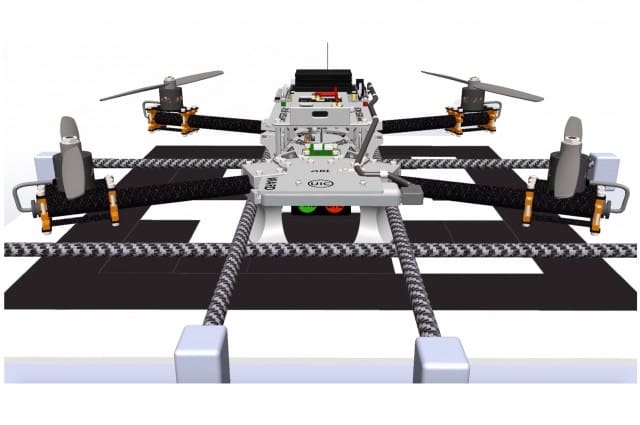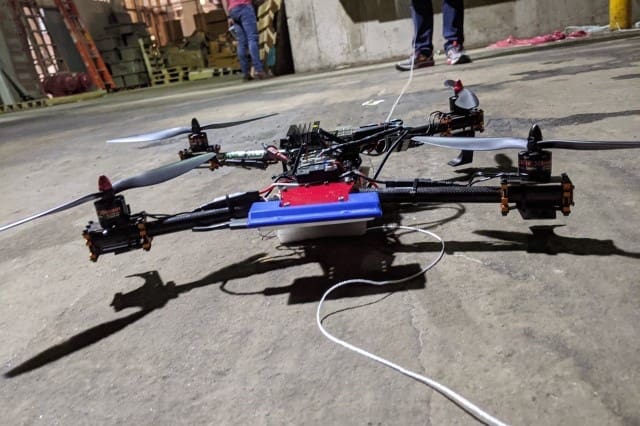
ABERDEEN PROVING GROUND, Md. — A swarm of hundreds of unmanned air vehicles will soon descend on unmanned ground vehicles to autonomously recharge, thanks to U.S. Army-funded research now underway at the University of Illinois Chicago.
The U.S. Army Combat Capabilities Development Command’s Army Research Laboratory awarded the University of Illinois Chicago a four-year, $8 million cooperative agreement in August to develop foundational science in two critical propulsion and power technology areas for powering future families of unmanned aircraft systems, or UASs.
This collaborative program will help small battery-powered drones autonomously return from military missions to unmanned ground vehicles for recharging. The university is developing algorithms to enable route planning for multiple teams of small unmanned air and ground vehicles.
Dr. Mike Kweon, program manager for the laboratory’s Versatile Tactical Power and Propulsion Essential Research Program, said the research on route planning is critical to the Army, which needs intelligent, small UASs that can find optimal routes during a military mission to autonomously return to unmanned ground vehicles, known as UGVs, for recharging. This will optimize the operational range extension and time on mission.
“Imagine in the future, the Army deploying a swarm of hundreds or thousands of unmanned aerial systems,” Kweon said. “Each of these systems has only roughly 26 minutes with the current battery technologies to conduct a flight mission and return to their home before they lose battery power, which means all of them could conceivably return at the same time to have their batteries replaced.”
This future concept is based on the reality of today’s technology, Kweon said.

“Soldiers would need to carry a few thousand batteries on missions to facilitate this, which is logistically overwhelming and overall, not conducive to a leading expeditionary military operation,” he said. “With this research project, we’re operationalizing scientific endeavors to increase Soldier readiness on the battlefields of tomorrow.”
The use of fast, recharging batteries and wireless power transfer technologies will allow multiple small UASs to hover around unmanned ground vehicles for wireless charging, and this will not require Soldier involvement.
“I believe this is the only way to realize practical UAS swarming, and small UAS and UGV teaming. Without solving how to handle the energy demand, all other advanced technologies using artificial intelligence and machine learning will be useless for the Army,” Kweon said. “On the battlefield, we do not have luxury to replace batteries for 100s of UAVs and recharging them for hours.”
For larger drones, Army-funded research will explore the fundamental science needed to develop miniaturized fuel sensors for future multi-fuel hybrid electric propulsion systems.
Fuel property sensors that university partners are developing will help Soldiers who operate fuel-based equipment measure fuel property in real time for the Army’s air and ground vehicles, Kweon said.
This knowledge will allow Army personnel to prevent catastrophic failures of the systems and to increase its performance and reliability.
“This research is critical not only for air vehicles but also ground vehicles, especially for the Army missions,” Kweon said. “The fuel sensor is telling the operator what type of fuel is being delivered from the fuel tank to the engine. This input signal can be used to intelligently tell the engine to adjust engine control parameters according to the fuel type to avoid any failures. This data can also be used to find root-cause failures if any engine component prematurely failed.”
The university’s current research in fuel sensor development examines the effects of fuel structure and chemistry on ignition in future multi-fuel drone engines so that real-time control can be implemented. This project further explores the underpinning science using advanced techniques including spectroscopic diagnostics and data science analysis to both enable and accelerate real-time control.
“It also enriches the understanding of the ignition of any unconventional fuel that may need to be burned in the drone engines,” said Prof. Patrick Lynch, a principal investigator at the University of Illinois Chicago on this project.
Army researchers said there is a lot of enthusiasm about partnering through the Open Campus model.
“This not only advances the state of the art, but also operationalizes science for transformational overmatch–the mission of the CCDC Army Research Laboratory,” said Dr. Mark Tschopp, ARL Central regional lead. “What is great is that we are expanding the team to include experts in academia, small businesses, and industry to push concepts and ideas into future capabilities for the Army. In a partnership with the Army, the University of Illinois Chicago brings subject matter expertise, unique facilities and a diverse student body in a collaborative partnership with Army scientists to advance these technologies and to provide future capabilities for the warfighter.”
This university-led research project is one of 11 funded this summer by the Army’s corporate research laboratory as a part of Center for UAS Propulsion efforts to develop technologies for multi-fuel capable hybrid-electric engines and fast efficient energy distribution. Each university partner is helping the Army address the energy demand required to power future unmanned vehicles. Universities also awarded for similar research are the University of Minnesota; University of Michigan; University of Wisconsin-Madison; University of Illinois-Urbana Champaign; Iowa State University; University of Delaware; University of North Texas; Texas A&M University; University of Missouri and University of Tennessee-Knoxville.
The research, slated to begin this fall, is part of a larger research portfolio of multi-fuel capable hybrid-electric technologies led by the laboratory that supports the Army Modernization Priority for Future Vertical Lift. Most recently, the laboratory recently announced the development of a new, advanced scientific model that will allow vehicle maintenance specialists to turn to bio-derived fuels in austere locations, and efforts to convert a home-based generator into a power source for autonomous ground and air vehicles.
By U.S. Army CCDC Army Research Laboratory Public Affairs

